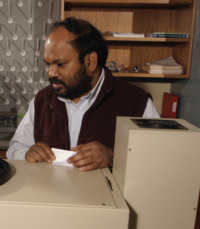Rajendra Rathore (chemist)
Rajendra Rathore (December 12, 1961 – February 16, 2018) was an organic chemist and professor at Marquette University in Milwaukee, Wisconsin as Pfletschinger-Habermann professor of organic chemistry.[1] He made important contributions in the area of supramolecular chemistry,[2][3] synthesis of novel electro-active molecules,[4] and drug discovery.[5][6] Rathore died on February 16, 2018 after complications from chronic pulmonary sarcoidosis.[7][8]
Rajendra Rathore | |
|---|---|
 Dr. Rajendra Rathore in his chemistry lab | |
| Born | December 12, 1961 Kannauj, Uttar Pradesh, India |
| Died | February 16, 2018 (aged 56) |
| Nationality | USA |
| Alma mater | |
| Awards |
|
| Scientific career | |
| Fields | Organic chemistry |
| Institutions | |
| Thesis | Stereoelectronic Effects, Mechanism, and Synthesis in Sulfonyl Chemistry (1990) |
Education
Rajendra Rathore received his M.Sc. from the Indian Institute of Technology Kanpur in 1986, under the mentorship of S. Chandrasekaran. He earned his Ph.D. in organic chemistry from the University of Western Ontario in London, Canada in 1990. He was a post-doctoral research associate and then a visiting assistant professor during 1992-2000 at the University of Houston under the supervision of Jay Kochi.[9] Rajendra Rathore joined the faculty at Marquette University in 2000.
Research
Dr. Rathore was the Pfletschinger-Habermann Professor of Organic Chemistry at Marquette University. He was also nominated for the Helen Way Klingler College of Arts and Sciences Scholar of the Year for 2017-2018, in recognition of outstanding scholarly contributions over the past three years, which he was awarded and received posthumously.[10] Rathore made key contributions to the areas of organic supramolecular and materials chemistry. His interests focused in rational design and synthesis of novel electro-active molecules with applications in molecular recognition, photovoltaics, molecular electronics, and drug discovery. In particular, Rathore was well known for his contributions to studies of the Scholl reaction mechanism, syntheses of cofacially arrayed polyfluorenes, and applications of nitric oxide complexes with aromatic donors. His recent work was focused on elucidating the application of frontier molecular orbitals (FMOs) in the rational design of novel charge-transfer materials.
Synthesis of pillarene
In 1995 Rathore and Kochi reported a synthetic procedure to produce various diarylmethanes from their corresponding benzyl methyl ethers.[11] They showed that transformation of bis(methoxymethyl)-p-hydroquinone ether yields corresponding diarylmethane and a polymeric-like material. A reanalysis of this polymeric material showed that it consisted mainly from pillararene.[12] A full characterization of pillararene was first reported in 2008 by Tomoki Ogoshi et al.[13]
Legacy
In October 2018, Marquette University held the Rajendra Rathore Memorial Symposium. Dr. Rathore had a great passion for teaching chemistry and mentoring young scientists, and this symposium started the Rajendra Rathore Memorial Scholarships at both Marquette University and Indian Institute of Technology - Kanpur, Raj's alma mater. These funds aim to continue Raj's legacy as an incredible force in guiding young scientists. To that end, both Marquette University and IIT Kanpur also instituted seminar series to keep Raj's passion for collaboration and discussion among scientists alive.
Personal life
Rajendra Rathore was born in Kannauj, India in 1961. In college in Kanpur, India, he met his wife, Rajni. Raj was a devoted husband and father of two girls. He enjoyed cooking and throwing dinner parties for his friends and family.
In October 2018, Marquette University held the Rajendra Rathore Memorial Symposium,[14] where friends and colleagues of Rathore spoke about their research and Rathore's influence on their science and lives. Most notably, all commented on Rathore's passion for science, how he made them feel as if "their science was the most exciting thing he had ever heard," and how his guidance and mentorship shaped the way they viewed the teaching and practice of science.
References
- Rajendra Rathore Biography. Marquette University
- Rathore, Rajendra; Burns, Carrie L. (May 2003). "A Practical One-Pot Synthesis of Soluble Hexa-peri-hexabenzocoronene and Isolation of Its Cation-Radical Salt". The Journal of Organic Chemistry. 68 (10): 4071–4074. doi:10.1021/jo034271e. PMID 12737593.
- Navale, Tushar S.; Ivanov, Maxim V.; Hossain, Mohammad M.; Rathore, Rajendra (15 January 2018). "FHBC, a Hexa-peri-hexabenzocoronene-Fluorene Hybrid: A Platform for Highly Soluble, Easily Functionalizable HBCs with an Expanded Graphitic Core". Angewandte Chemie International Edition. 57 (3): 790–794. doi:10.1002/anie.201711739. PMID 29194947.
- Rathore, Rajendra; Abdelwahed, Sameh H.; Guzei, Ilia A. (July 2003). "Synthesis, Structure, and Evaluation of the Effect of Multiple Stacking on the Electron-Donor Properties of π-Stacked Polyfluorenes". Journal of the American Chemical Society. 125 (29): 8712–8713. doi:10.1021/ja035518s.
- Ramchandran, Ramani; Sem, Daniel; Rathore, Rajendra. "US Patent Application for SMALL MOLECULE ANTAGONISTS OF DUSP5 AND METHODS OF USE Patent Application (Application #20180000778 issued January 4, 2018) - Justia Patents Search". patents.justia.com. Retrieved 31 May 2018.
- "Milwaukee doctor imagines better umbilical cord clamp". Retrieved 31 May 2018.
- "Klingler College of Arts and Sciences 2018 Awards". medium.com. 19 April 2018. Retrieved 31 May 2018.
- "Rajendra Rathore – Krause Funeral Home". www.krausefuneralhome.com.
- Rathore, Rajendra (17 November 2008). "Jay Kazuo Kochi (1927-2008)". Angewandte Chemie International Edition. 47 (48): 9186. doi:10.1002/anie.200805187.
- "KLINGLER COLLEGE AWARDS". Marquette University.
- Rathore, Rajendra; Kochi, Jay K. (November 1995). "Radical-Cation Catalysis in the Synthesis of Diphenylmethanes via the Dealkylative Coupling of Benzylic Ethers". The Journal of Organic Chemistry. 60 (23): 7479–7490. doi:10.1021/jo00128a020.
- Ivanov, Maxim V.; Wang, Denan; Navale, Tushar S.; Lindeman, Sergey V.; Rathore, Rajendra (19 February 2018). "From Intramolecular (Circular) in an Isolated Molecule to Intermolecular Hole Delocalization in a Two-Dimensional Solid-State Assembly: The Case of Pillarene". Angewandte Chemie International Edition. 57 (8): 2144–2149. doi:10.1002/anie.201712159. PMID 29327390.
- Ogoshi, Tomoki; Kanai, Suguru; Fujinami, Shuhei; Yamagishi, Tada-aki; Nakamoto, Yoshiaki (April 2008). "-Bridged Symmetrical Pillar[5]arenes: Their Lewis Acid Catalyzed Synthesis and Host–Guest Property". Journal of the American Chemical Society. 130 (15): 5022–5023. doi:10.1021/ja711260m. PMID 18357989.
- "Rathore Symposium | Department of Chemistry | Marquette University". www.marquette.edu. Retrieved 22 October 2018.